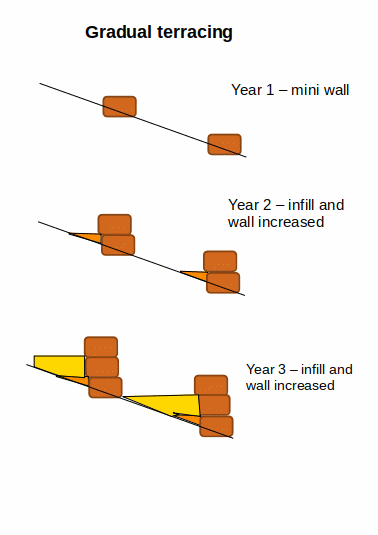
 2
2








 1
1




"the qualities of these bacteria, like the heat of the sun, electricity, or the qualities of metals, are part of the storehouse of knowledge of all men. They are manifestations of the laws of nature, free to all men and reserved exclusively to none." SCOTUS, Funk Bros. Seed Co. v. Kale Inoculant Co.
 1
1




The ultimate goal of farming is not the growing of crops, but the cultivation and perfection of human beings. - Masanobu Fukuoka
 1
1




Brenda
Bloom where you are planted.
http://restfultrailsfoodforestgarden.blogspot.com/
 6
6




 1
1




paul wheaton wrote:
A few years ago, Joel Salatin wrote about the value of putting in permanent fences along countour lines. It helps to build a sort of poor man's swale.
 1
1




Brenda
Bloom where you are planted.
http://restfultrailsfoodforestgarden.blogspot.com/
 3
3





 9
9




I also believe that instead of building large walls and doing lots of work, one could build a very small wall and let gravity/erosion gradually move the soil. These walls might only grow by a few inches each year, as part of a process of moving the rocks out of fields.

How Permies works: https://permies.com/wiki/34193/permies-works-links-threads
My projects on Skye: The tree field, Growing and landracing, perennial polycultures, "Don't dream it - be it! "
 7
7




Nancy Reading wrote:...Also the soil has to come from somewhere - either infill brought in, or from up hill (which could undermine terrace walls above).
Visit Redhawk's soil series: https://permies.com/wiki/redhawk-soil
How permies.com works: https://permies.com/wiki/34193/permies-works-links-threads
 7
7
















 1
1




Jordan Lowery wrote:the chickens will scratch downhill as they ALWAYS do. over time of adding material they will fill up the terraces with there scratched scraps, weeds and waste, a little bit of soil and of course there manure. let sit for a month or two or over winter. come spring you have leveled terraces, rich in organic matter, full of nutrients.
How Permies works: https://permies.com/wiki/34193/permies-works-links-threads
My projects on Skye: The tree field, Growing and landracing, perennial polycultures, "Don't dream it - be it! "
 2
2




Invasive plants are Earth's way of insisting we notice her medicines. Stephen Herrod Buhner
Everyone learns what works by learning what doesn't work. Stephen Herrod Buhner




Moderator, Treatment Free Beekeepers group on Facebook.
https://www.facebook.com/groups/treatmentfreebeekeepers/

















 2
2




Michael Cox wrote:Flipping this round... why do gradual?
How Permies works: https://permies.com/wiki/34193/permies-works-links-threads
My projects on Skye: The tree field, Growing and landracing, perennial polycultures, "Don't dream it - be it! "
 6
6




 4
4




 2
2





|
But how did the elephant get like that? What did you do? I think all we can do now is read this tiny ad:
Homestead Pigs Course
https://permies.com/wiki/365748/Homestead-Pigs
|


